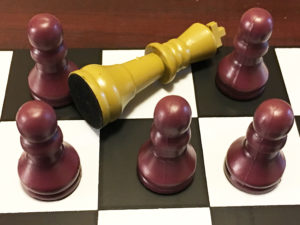 By Steve Brawner
By Steve Brawner
© 2017 by Steve Brawner Communications, Inc.
Donald Trump won the Republican Party nomination because he was playing checkers while the other candidates were playing chess, and it was a checkers year. In November, the opposite happened: He checkmated Hillary Clinton while she was playing checkers.
Remember the primaries? Those 16 other mostly conventional Republican candidates were all playing chess – trying to execute their grand strategies and position themselves for Trump’s inevitable fade, or to be the last person standing against him. While they were staring at the chessboard, he just kept bouncing from state to state on the checkerboard until he reached the back row and shouted, “King me!”
In the general election, however, it was Clinton who tried to play checkers, while Trump realized it had become a chess match.
Checkers is a simple game, which is why we don’t hear much about “checkers masters.” The strategy involves a balance of offense and defense: You try to reach the opponent’s back row without allowing them to reach yours. If you play too aggressively, you leave yourself open, so it’s best just to plod along, pick up pieces and look for the double jumps.
That’s what Clinton did. Once she had that small lead in the polls, she played it safe and ran a same-old, same-old campaign. She didn’t reach out to voters who ordinarily wouldn’t support Democrats; those were discarded into her “basket of deplorables” and forgotten about. She thought her back row was protected by that supposed “blue wall” of states like Michigan and Pennsylvania that of course would vote for the Democrat because they always had. When that old Trump video where he talked about grabbing women surfaced, she thought she’d made a double jump right onto his back row.
Trump, meanwhile, was playing chess. Chess is an offensive game where you win by taking the opponent’s king regardless of what it costs you, and often by surprising the opponent. With checkers, you always know who’s winning; with chess, the player with fewer pieces can suddenly strike and end the game. So while Clinton’s campaign (and most pundits) were counting the number of checkers left on the board, Trump’s campaign found some holes in that blue wall and exploited them.
Meanwhile, Trump did what Clinton refused to do or could not do – find new voters.
The modern Republican Party has been an awkward coalition of business elites and socially conservative regular Americans whose interests sometimes conflict, particularly lately when those business elites are getting really rich while many regular Americans are struggling.
Trump saw that there are a lot more regular Americans than there are business elites, and some who typically vote for Democrats could become his voters. He could speak to them in a way that Mitt Romney couldn’t in 2012 because Trump is blunt and earthy and understands popular culture, and because Clinton, the daughter of a middle class Chicago small businessman, had become one of those elites herself. He wasn’t going to lose the regular Americans he already had, and he didn’t need the elites’ money because he’s already rich, he was getting so much free air time, and he’s a wizard at using free social media.
He realized that he could appeal to regular Americans’ legitimate fears and concerns – and, for some, to their misplaced grievances and their unacknowledged prejudices – by using the most effective and darkest campaign slogan in recent American history. A lot’s implied in “Make America Great Again,” especially that last word, “again,” as in, “It used to be great, but it’s not now, and here are the groups of people responsible for that.”
In the end, Clinton had 3 million more votes across the country, but Trump won the states that mattered most. Her checkerboard had more pieces, and so did her chessboard, but the checkers game didn’t matter, and he had surrounded her king with a bunch of pawns.
He recognized what no other candidates saw this election except perhaps Sen. Bernie Sanders – that the game was different this time. In fact, both games were, and the trick was knowing when to play which. That’s why the Republicans who were playing chess had to king him in checkers. That’s why he captured Clinton’s king in the general election chess match while she was moving her checkers around the board. And that’s why he’s the nation’s 45th president, and they’re not.
Related: Trump played checkers and they played chess – in a checkers year
Great analogy and analysis, Steve …
Thanks, Lance. I owe you a book, by the way.
Good column, Steve. Though I think it behooves us to acknowledge that Trump, in a pretty unprecedented way, used bald-faced lies and a lot of misinformation and thinly veiled xenophobic language to win over voters. Of course, lying and xenophobia have been around in politics since the dawn of time, but Trump took this to a new level, in what I have heard called the post-truth era. To some voters it didn’t matter that much of what Trump was saying was obviously untrue… it made them feel better.
All true, Adam.